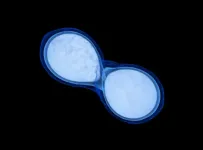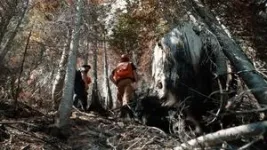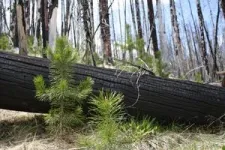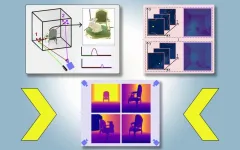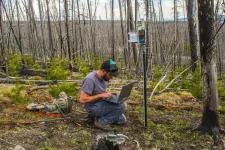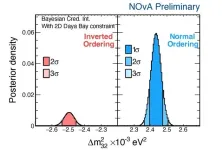(Press-News.org) UNIVERSITY PARK, Pa. — When stars collapse, they can leave behind incredibly dense but relatively small and cold remnants called neutron stars. If two stars collapse in close proximity, the leftover binary neutron stars spiral in and eventually collide, and the interface where the two stars begin merging becomes incredibly hot. New simulations of these events show hot neutrinos — tiny, essentially massless particles that rarely interact with other matter — that are created during the collision can be briefly trapped at these interfaces and remain out of equilibrium with the cold cores of the merging stars for 2 to 3 milliseconds. During this time, the simulations show that the neutrinos can weakly interact with the matter of the stars, helping to drive the particles back toward equilibrium — and lending new insight into the physics of these powerful events.
A paper describing the simulations, by a research team led by Penn State physicists, appeared in the journal Physical Reviews Letters.
“For the first time in 2017, we observed here on Earth signals of various kinds, including gravitational waves, from a binary neutron star merger,” said Pedro Luis Espino, a postdoctoral researcher at Penn State and the University of California, Berkeley, who led the research. “This led to a huge surge of interest in binary neutron star astrophysics. There is no way to reproduce these events in a lab to study them experimentally, so the best window we have into understanding what happens during a binary neutron star merger is through simulations based on math that arises from Einstein’s theory of general relativity.”
Neutron stars get their name because they are thought to be composed almost entirely out of neutrons, the uncharged particles that, along with positively charged protons and negatively charged electrons, make up atoms. Their incredible density — only black holes are smaller and denser — is thought to squeeze protons and electrons together, fusing them into neutrons. A typical neutron star is only tens of kilometers across but has about one-and-a-half times the mass of our Sun, which is about 1.4 million kilometers across. A teaspoon of neutron star material might weigh as much as a mountain, tens or hundreds of millions of tons.
“Neutron stars before the merger are effectively cold, while they may be billions of degrees Kelvin, their incredible density means that this heat contributes very little to the energy of the system,” said David Radice, assistant professor of physics and of astronomy and astrophysics in the Eberly College of Science at Penn State and a leader of the research team. “As they collide, they can become really hot, the interface of the colliding stars can be heated up to temperatures in the trillions of degrees Kelvin. However, they are so dense that photons cannot escape to dissipate the heat; instead, we think they cool down by emitting neutrinos.”
According to the researchers, neutrinos are created during the collision as neutrons in the stars smash into each other and are blasted apart into protons, electrons and neutrinos. What then happens in those first moments after a collision has been an open question in astrophysics.
To try to answer that question, the research team created simulations requiring massive amounts of computing power that model the merger of binary neutron stars and all of the associated physics. The simulations showed for the first time that, however briefly, even neutrinos can be trapped by the heat and density of the merger. The hot neutrinos are out of equilibrium with the still cool cores of the stars and can interact with the matter of the stars.
“These extreme events stretch the bounds of our understanding of physics and studying them allows us to learn new things,” Radice said. “The period where the merging stars are out of equilibrium is only 2 to 3 milliseconds, but like temperature, time is relative here, the orbital period of the two stars before the merge can be as little as 1 millisecond. This brief out-of-equilibrium phase is when the most interesting physics occurs, once the system returns to equilibrium, the physics is better understood.”
The researchers explained that the precise physical interactions that occur during the merger can impact the types of signals that could be observed on Earth from binary star mergers.
“How the neutrinos interact with the matter of the stars and eventually are emitted can impact the oscillations of the merged remnants of the two stars, which in turn can impact what the electromagnetic and gravitation wave signals of the merger look like when they reach us here on Earth,” Espino said. “Next-generation gravitation-wave detectors could be designed to look for these kinds of signal differences. In this way, these simulations play a crucial role allowing us to get insight into these extreme events while informing future experiments and observations in a kind of feedback loop.”
In addition to Espino and Radice, the research team includes postdoctoral scholars Peter Hammond and Rossella Gamba at Penn State; Sebastiano Bernuzzi, Francesco Zappa and Luís Felipe Longo Micchi at Friedrich-Schiller-Universität Jena in Germany; and Albino Perego at Università di Trento in Italy.
Funding from the U.S. National Science Foundation; the U.S. Department of Energy (DOE), Office of Science, Division of Nuclear Physics; the Deutsche Forschungsgemeinschaft; and the European Union Horizon 2020 and Europe Horizon initiatives supported this research. Simulations were performed on Bridges2, Expanse, Frontera and Perlmutter supercomputers. The research used resources of the National Energy Research Scientific Computing Center, a DOE Office of Science User Facility supported by the Office of Science of the U.S. Department of Energy. The authors acknowledged the Gauss Centre for Supercomputing e.V. for funding this project by providing computing time on the GCS Supercomputer SuperMUC-NG at the Leibniz Supercomputing Centre.
END
What happens when neutron stars collide?
New simulations show that neutrinos created during these cataclysmic events are briefly out of thermodynamic equilibrium with the cold cores of the merging stars
2024-06-18
ELSE PRESS RELEASES FROM THIS DATE:
Researchers leverage shadows to model 3D scenes, including objects blocked from view
2024-06-18
Imagine driving through a tunnel in an autonomous vehicle, but unbeknownst to you, a crash has stopped traffic up ahead. Normally, you’d need to rely on the car in front of you to know you should start braking. But what if your vehicle could see around the car ahead and apply the brakes even sooner?
Researchers from MIT and Meta have developed a computer vision technique that could someday enable an autonomous vehicle to do just that.
They have introduced a method that creates physically accurate, 3D models of an entire scene, including areas blocked from view, ...
Is coffee good for you or bad for you?
2024-06-18
Coffee drinking is a heritable habit, and one that carries a certain amount of genetic baggage.
Caffeinated coffee is a psychoactive substance, notes Sandra Sanchez-Roige, Ph.D., an associate professor in the University of California San Diego School of Medicine Department of Psychiatry. She is one of an international group of researchers that compared coffee-consumption characteristics from a 23andMe database with an even larger set of records in the United Kingdom. She is the corresponding author of a study recently published in the journal Neuropsychopharmacology.
Hayley ...
CWRU researcher, interdisciplinary team discover breakthrough on body’s adaptation to COVID-19
2024-06-18
CLEVELAND—Since 2020, the COVID-19 pandemic has presented significant challenges to global public health, infecting millions and claiming numerous lives. While widespread vaccination efforts have alleviated the immediate threat, lingering questions persist about the long-term effects of the virus on those infected.
An interdisciplinary team of scientists has made a significant breakthrough to understand how the body adapts to COVID-19 infection, potentially offering crucial insights into managing the complex disease. Led by Christopher Wilson, professor of medicine at Loma Linda University, the collaborative effort involved ...
New guidelines for radiation therapy for HPV-associated head and neck cancer
2024-06-18
Study Title: Radiation Therapy for HPV-Positive Oropharyngeal Squamous Cell Carcinoma: An ASTRO Clinical Practice Guideline
Publication: Practical Radiation Oncology
Dana-Farber Cancer Institute author: Danielle Margalit, MD, MPH
Summary: A multi-disciplinary task force convened by the American Society for Radiation Oncology has issued new guidelines for radiation therapy for HPV-associated oropharyngeal squamous cell carcinoma (OPSCC). The expert task force recommends optimal dosing regimens for radiation therapy when used alone or after surgery, incorporating the latest data on minimizing doses to areas that may affect patient quality of life such as swallowing. ...
Argonne’s South Side STEM Opportunity Landscape Project dedicated to STEM equity wins Societal Impact Award
2024-06-18
The Argonne in Chicago South Side STEM Opportunity Landscape Project was awarded the Societal Impact Award by the Chicago Council on Science and Technology (C2ST) for its commitment to advancing equity and opportunity in STEM education and careers across underserved communities.
C2ST is a nonprofit that works to inspire and engage all segments of society about science and technology and their contributions to society. The South Side STEM Opportunity Landscape Project is part of Argonne in Chicago, which is focused on driving inclusive innovation to advance economic and societal impacts for underserved and underrepresented communities. The ...
Wildfire resilience initiative launches with $3.7 million in seed funding from the Gordon and Betty Moore Foundation
2024-06-18
The Gordon and Betty Moore Foundation has awarded $3.7 million to kickstart the Western Fire & Forest Resilience Collaborative, led by Winslow Hansen, a forest ecologist at Cary Institute of Ecosystem Studies. Funds are enabling the formation of an interdisciplinary collaborative that will advance science-based management solutions to the growing wildfire crisis.
In the Western US, climate change and a legacy of fire suppression have led to larger, more severe, and more frequent fires — with devastating consequences for people, natural resources, and the climate. By dramatically speeding ...
New NOvA results add to mystery of neutrinos
2024-06-18
The international NOvA collaboration presented new results at the Neutrino 2024 conference in Milan, Italy, on June 17. The collaboration doubled their neutrino data since their previous release four years ago, including adding a new low-energy sample of electron neutrinos. The new results are consistent with previous NOvA results, but with improved precision. The data favor the “normal” ordering of neutrino masses more strongly than before, but ambiguity remains around the neutrino’s oscillation properties.
The latest NOvA data provide a very precise measurement ...
Gastroenterologists generally trust and accept use of AI medical tools in clinics and hospitals, finds NTU Singapore study
2024-06-18
Artificial intelligence (AI) has permeated many aspects of medicine, with promises of accurate diagnoses, better management decisions, and improved outcomes for both patients and the healthcare system. However, to successfully implement AI technology in clinical practice, trust and acceptance among healthcare providers to use such tools is crucial.
Now, using the treatment of digestive diseases as a case study, an international study led by Nanyang Technological University, Singapore (NTU Singapore) has found that doctors in the gastroenterology practice generally trust and accept AI medical tools.
Through ...
State cannabis legalization and trends in cannabis-related disorders in older adults
2024-06-18
About The Study: Rates of cannabis-related disorder encounters increased from 2017 through 2022 among Medicare-insured older adults. This study observed the highest rates in states or territories that legalized adult and medical use of cannabis. The results also suggest higher average annual increases in states or territories that legalized medical cannabis.
Corresponding author: To contact the corresponding author, Silvia Perez-Vilar, Ph.D., Pharm.D., email silvia.perezvilar@fda.hhs.gov
To access the embargoed study: Visit our For The Media ...
Availability of medications for opioid use disorder in community mental health facilities
2024-06-18
About The Study: In this study of 450 community outpatient mental health treatment facilities in 20 high-burden states, approximately one-third offered medications for opioid use disorder (MOUD). These results suggest that further study is needed to report MOUD uptake, either through increased prescribing at all clinics or through effective referral models.
Corresponding author: To contact the corresponding author, Jonathan Cantor, Ph.D., email jcantor@rand.org.
To access the embargoed study: Visit our For The Media website at this link ...
LAST 30 PRESS RELEASES:
Autonomous AI agents developed to detect early signs of cognitive decline
Study finds ocean impacts nearly double economic cost of climate change
Increased deciduous tree dominance reduces wildfire carbon losses in boreal forests
Researchers discover how a respiratory bacterium obtains essential lipids from the human body and targets fat-rich tissues
Locust swarms destroy crops. Scientists found a way to stop that
More resources and collaboration needed to support prevention and treatment of obesity
Two types of underconfidence linked to anxiety and gender
Insects are victims too: Global study shows impacts of invasive alien species on populations
Pioneering natural, degradable polymer capsules
Forestry is becoming digital and automated
Maternity baby deaths much higher in northern England than in the South
Mosquitoes’ thirst for human blood has increased as biodiversity loss worsens
The stop-smoking medication varenicline may also work for cannabis use disorder
Potential new treatment for sepsis
Study reveals how many hours of video games per week might be too many
Electrospinning for mimicking bioelectric microenvironment in tissue regeneration
Home fingertip oxygen monitors less accurate for people with darker skin tones
Six weeks in a cast no less effective than surgery for unstable ankle fractures
Precautionary approach to alcohol-free and low alcohol drinks needed to protect public health, say experts
Gas-atomized Ca–Mg alloy powders produce hydrogen simply by adding water — high-efficiency hydrogen generation at room temperature
British redcoat’s lost memoir reveals harsh realities of life as a disabled veteran
World-leading rare earth magnet recycling facility launches in UK
Corday Selden selected for the Oceanography Society Early Career Award
MIT chemists determine the structure of the fuzzy coat that surrounds Tau proteins
Same moves, different terrain: How bacteria navigate complex environments without changing their playbook
Severe weather is deadly for vulnerable older adults long after the storm ends, study finds
Expert panel highlights opportunities for improving cancer studies
Hearing aid prescriptions not associated with changes in memory and thinking
Seth Zippel selected for The Oceanography Society Early Career Award
Jeremy Horowitz selected for The Oceanography Society Early Career Award
[Press-News.org] What happens when neutron stars collide?New simulations show that neutrinos created during these cataclysmic events are briefly out of thermodynamic equilibrium with the cold cores of the merging stars
